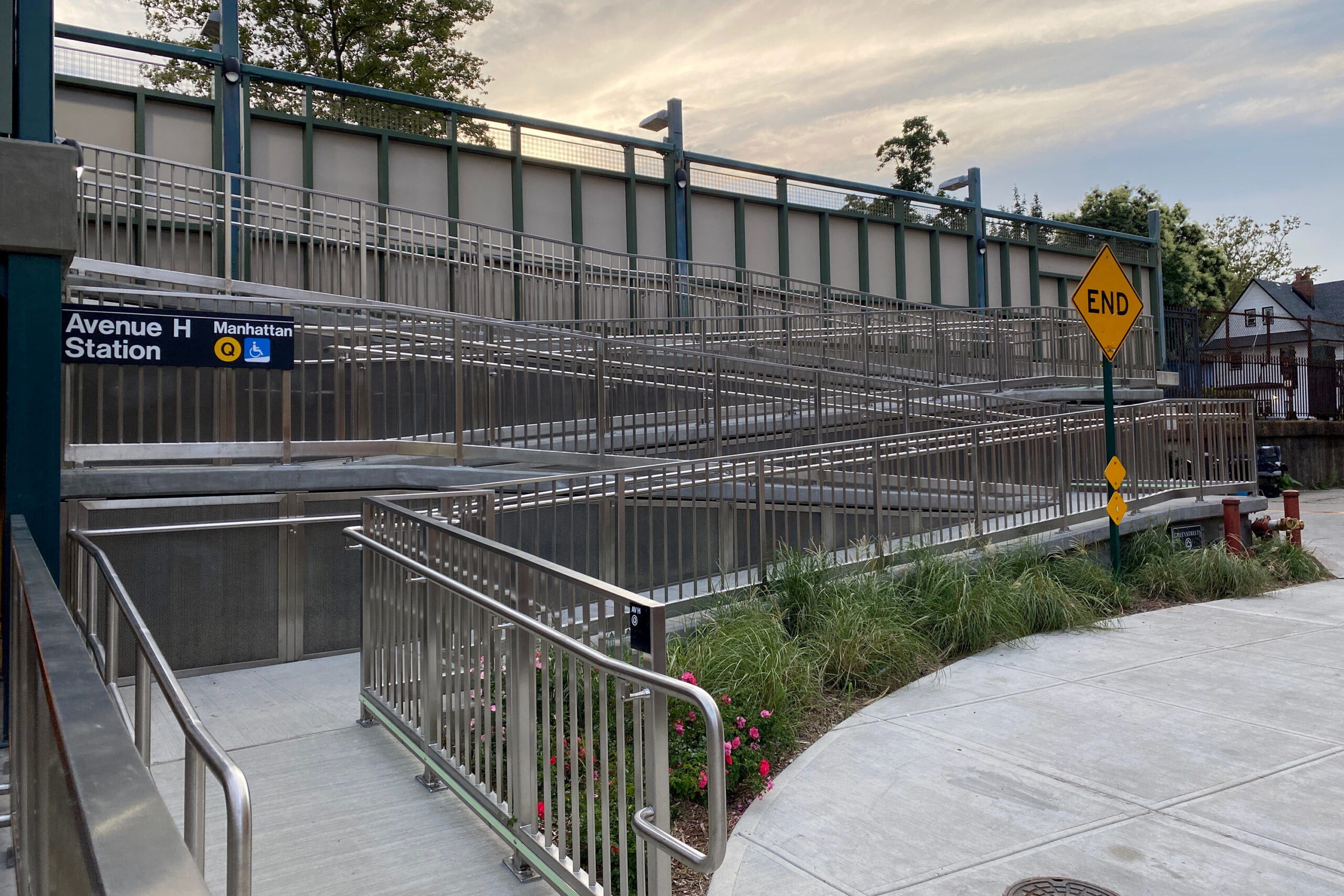As the MTA looks to increase accessibility in the subway system, top transit officials say pricey elevators are not the only way to open more stations to riders with disabilities.
Many are inclined toward a simpler solution.
“Ramps are failproof,” Quemuel Arroyo, the MTA’s chief accessibility officer, said last month when the Avenue H stop in Brooklyn became fully accessible via a ramp leading to the station’s northbound platform. “I hope to see more of them throughout our entire network.”
But the $14 million project at the Q line station also highlights the challenges the transit agency faces in adding gradients to a system in which fewer than 30% of the nearly 500 stops in the subway and Staten Island Railway are fully compliant with the Americans with Disabilities Act.
There are currently 26 ramps in 14 stations, according to the MTA. Yet some — like the one in the passageway connecting Times Square-42nd Street to the Port Authority — are too steep for ADA standards.
“More ramps are definitely needed,” Dan DeBrucker, who has two prosthetic legs, said after walking up a ramp that runs between the A/C/E line platforms and mezzanine level at the 42nd Street/Port Authority Bus Terminal subway station. “I think the whole system should be brought up to speed or made ADA compliant.”
But the upgrades at Avenue H, which was the first ADA project to be completed as part of the MTA’s 2020-2024 Capital Program, show the complexities that accompany trying to add more ramps to the transit system.
A 20-inch water main and an 8-inch gas main had to be moved, according to the MTA, to accommodate the winding design and a new underpass that leads to the southbound platform’s ramp. In all, the work totaled $14 million — considerably lower than the cost of installing elevators.
“Ramps are not easy,” Arroyo said. “But ramps can be a lot less expensive and would never fail.”
Arroyo said the MTA, in many cases, lacks the space it needs to add ramps which meet ADA requirements.
“The hardship is really space constraint,” Arroyo told THE CITY.
As part of its next five-year, $51 billion capital plan, the MTA has committed to spending more than $5 billion to make 70 more stations fully accessible. It’s not clear how many of those will include ramps.
“Ramps are bridges, bridges to accessibility,” said Victor Calise, an MTA board member and wheelchair user. “We need more of that.”
Not So Fast
Susanna Baragiula, who was pushing a stroller with her service dog up a ramp at the Avenue H stop, which now has ramps serving both platforms, said the latest addition to the station is “very convenient.”
“It makes things a lot easier and it helps me be more independent,” said Baragiula, 62. “Before I had to take the dog off, close the stroller and lift it up with all my medical baggage.”
Advocates for people with disabilities have been less enthusiastic about ramps as a way to expand accessibility in the subway, saying they don’t take into account the full scale of those with limited mobility.
The MTA, which has completed 11 ADA projects since the start of 2020, has over the years been hit with multiple lawsuits for not including elevators in station renovations.
Sharon McLennon-Wier, executive director of the Center for Independence of the Disabled in New York, pointed out that even ramps can be daunting to people with certain mobility issues, while elevators tend to work for just about everybody.
“Trust me, if anybody broke their leg, walking on crutches is a nightmare and that would be a very long, laborious process,” said McLennon-Wier. “You can’t just say we’re going to do one instead of the other.”
McLennon-Wier, who is blind, said the MTA could use “a more universal design” in subway planning.
“You have to look at the station, think about the population that you’re serving and think of the ways that all users are going to get to that train,” she said.
The Next Steps
In 2018, the MTA hired Stantec, a Canadian engineering consulting firm, to study the feasibility of making non-accessible stations compliant with the 31-year-old ADA, which requires equal access for all.
The first phase of the $17.6 million study, which was obtained by THE CITY, looked at 100 stations and found that almost all could be retrofitted with elevators.
The study pointed out that the 103rd Street stop on the No. 1 line could have enough space for 140-foot-long ramps running between the station’s mezzanine level and its platforms.
But adding the ramps would require “heavy utility relocation work, as well as extensive support, maintenance and protection of utilities during construction,” according to a copy of the study.
“You’ll never know what you’re going to encounter until you get there and you start opening up,” Arroyo said.
The MTA has said Stantec finished the systemwide study, but has not released the results.
Dustin Jones, a wheelchair user who rides the subway daily from his home in the South Bronx, said he’s more concerned about people with disabilities gaining access to the transit system than about how they enter stations.
“The name of the game is accessibility,” said Jones, 33, of United for Equal Access New York, an advocacy organization. “I don’t care if it’s a flying horse — get me into the subway, so I can travel like the rest of my fellow New Yorkers.”
This article was originally posted on MTA Looks to Ramp Up Subway Accessibility With Fewer Costly Elevators






Be First to Comment